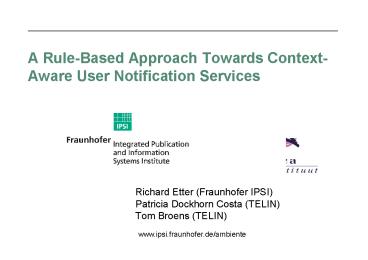A Rule-Based Approach Towards Context-Aware User Notification Services - PowerPoint PPT Presentation
Title:
A Rule-Based Approach Towards Context-Aware User Notification Services
Description:
... Awareness and Notification Service is part of the middleware EU-project AMIGO. ... is currently being deployed in the AMIGO Ambient Intelligence Environments. ... – PowerPoint PPT presentation
Number of Views:12
Avg rating:3.0/5.0
Title: A Rule-Based Approach Towards Context-Aware User Notification Services
1
A Rule-Based Approach Towards Context-Aware User
Notification Services
- Richard Etter (Fraunhofer IPSI)Patricia Dockhorn
Costa (TELIN) - Tom Broens (TELIN)
2
Pervasive Computing Environments
- Users are surrounded with ubiquitous
communication and information technology. - Unobtrusive services assist users in their daily
lives. - Context awareness has emerged as a central
element in pervasive computing. - Notification services are key applications.
3
Requirements for a User Notification Service
- Current middleware provides unified ways to
subscribe to and manage context data. - Key Issues
- A flexible, efficient and convenient mechanism to
allows user-applications to specify what changes
in the environment should be notified to them. - Tailor the user notification to the users
context.
4
ANS - A Rule-Based User Notification Service
- A rule-based approach relieves user-application
developers from regarding and logically combining
multiple context sources in their application. - ANS provides an expressive and simple language
that enables users (application developers) to
state what they are interested in. - ANS provides notifications based on the users
preferences and their current context
5
Design of ANS
6
ANS Rule Language
- The focus of the rule language is on the
following qualities - Expressive power the language permits the
specification of complex event relations. It
allows the use of logical connectives (e.g., AND,
OR, NOT) on conditions to build compound
conditions. - Convenient use for application developers It
provides high-level constructs that facilitate
event compositions. - Extensibility The language allows the addition
of new predicates to accommodate events being
defined on demand.
7
ANS Rule Language
Clause Semantics
Upon When Do Event part models an occurrence of interest in the context Condition part that specifies a condition that must hold prior the execution of the action Action part which consists of notification invocations.
Select Allows the selection from a collection using filtering expressions
Scope Allows parameterization of rules
always, once, from ltstartgt to ltendgt, to ltendgt, ltngt times, frequency ltngt times per ltperiodgt always, once, from ltstartgt to ltendgt, to ltendgt, ltngt times, frequency ltngt times per ltperiodgt
8
ANS Rule Language Examples
- Notify Jerry if his computer is online when he
leaves his room. - Upon leaveRoom (Jerry, Room101)
- When IsOnline (Jerry)
- Do Notify (Jerry, Jerry, your computer has been
left on)
9
Outlook
- The Awareness and Notification Service is part of
the middleware EU-project AMIGO. A first version
of the service is currently being deployed in the
AMIGO Ambient Intelligence Environments.
10
The End
- Thank you for your attention































